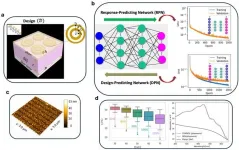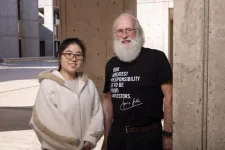Machine learning assisted plasmonic absorbers
2025-01-15
(Press-News.org) Light absorption is a cornerstone for several applications such as solar cells, photodetectors, and optical sensors, to name a few. Yet, the trade-off between the thickness of the absorber and its efficiency has long limited the performance of such devices. The goal in this investigation is to get the best of both worlds—ultra-thin materials with maximized absorption.
In a recent paper published in Light: Science & Applications, a group of researchers from King Abdullah University of Science and Technology (KAUST), led by Prof. Ying Wu and Prof. Xiangliang Zhang (now at University of Notre Dame), successfully put forward an efficient broadband light absorber within an ultrathin amorphous silicon layer embedded with silver nanorings. By combining tailored plasmonic design with deep learning techniques, the researchers achieved an unprecedented photonic enhancement of over 100%.
The team’s innovative approach involves combining concentric silver nanorings within an ultrathin silicon layer. These nanorings generate localized surface plasmons (which are intriguing collective oscillations of light that have led over the course of the last two decades to the vibrant field of plasmonics) that couple with the cavity modes of the structure to efficiently trap light. This interplay allows the thin silicon layer to absorb much more light without increasing its physical thickness.
One key contribution of this study consists of leveraging deep learning techniques to further optimize the design. To this end, the scientists developed two tailored neural networks: a response predicting network (RPN) to predict the absorption spectra for a given meta-absorber parameters, and a design predicting network (DPN) to solve the inverse problem, i.e., finding the best design for a desired absorption spectrum. The proposed study is shown to significantly reduce the time and computational resources needed for the metamaterial design.
“Our machine learning framework allows us to explore vast design spaces and suggest the optimal parameters with incredible precision,” notes Prof. Wu. This approach yielded a remarkable photonic enhancement of over 100% in comparison to previous state-of-the-art light absorbers. The study also stands out for its combination of theoretical and numerical predictions as well as optical experimental validation. The absorption spectrum of the fabricated metascreen absorber agrees with the simulated results, confirming the practicality of the design. The potential applications of this research are far-reaching: Enhanced light absorption opens-up possibilities for more efficient solar panels, advanced photodetectors, and tailored precise optical filters. Beyond energy and sensing, the ability to precisely control the optical properties of materials could also lead to breakthroughs in telecommunications, healthcare, and imaging technologies.
“This work not only advances our understanding of plasmonic meta-absorbers but also showcases how physics-informed deep learning can redefine the design and optimization process,” adds Prof. Wu.
Looking forward, the team plans to explore other geometries and configurations to push the boundaries of what is possible with different types of metasurfaces. Also, investigating the deployment of these absorbers in real-world settings, such as photovoltaic devices is the natural next step for the group. The combination of advanced physical modeling and AI-driven design is set to unlock new possibilities in optics and photonics, paving the way for highly efficient and customizable devices.
END
[Attachments] See images for this press release:

ELSE PRESS RELEASES FROM THIS DATE:
2025-01-15
Low back pain is a leading cause of disability worldwide with many treatments, such as medication, often failing to provide lasting relief. Researchers from the University of Sydney’s Centre for Rural Health have uncovered a possible solution. Their study, published in JAMA Network Open, found integrating lifestyle support into back pain care could reduce disability and enhance quality of life.
The randomised controlled trial included 346 participants from across Australia, all of whom had chronic low back pain and at least one lifestyle risk factor, such as obesity, poor diet, sedentary habits, or smoking. Participants were randomly assigned ...
2025-01-15
Waking up does not activate an increase in the release of the stress hormone cortisol. Cortisol does, however, increase in the hours prior to wakening as part of the body’s preparation for the next day, new research led by the University of Bristol has found. The study is published today [15 January] in the Proceedings of the Royal Society B.
For many years it has been generally accepted that waking up results in a stimulus to release hormone cortisol - a phenomenon called the “cortisol awakening response” (CAR). This response has been used to investigate many clinical conditions including PTSD, depression, obesity, and chronic ...
2025-01-15
MEDIA INQUIRES
WRITTEN BY
Laura Muntean
Olga ...
2025-01-15
The Lancet Diabetes & Endocrinology: Global Commission proposes major overhaul of obesity diagnosis, going beyond BMI to define when obesity is a disease.
Current medical approaches to diagnosing obesity rely on BMI which is not a reliable measure of health or illness at the individual level. This can result in misdiagnosis with negative consequences for people living with obesity and wider society.
The Commission on Clinical Obesity recommends a new, nuanced approach where measures of body fat - for example, waist circumference or direct fat measurement - in addition to BMI are used to detect obesity, therefore reducing the risk of misclassification.
Additionally, the ...
2025-01-14
Federal reservoirs could help meet the country’s solar energy needs, according to a new study published in Solar Energy.
For the study, Evan Rosenlieb and Marie Rivers, geospatial scientists at the U.S. Department of Energy National Renewable Energy Laboratory (NREL), as well as Aaron Levine, a senior legal and regulatory analyst at NREL, quantified for the first time exactly how much energy could be generated from floating solar panel projects installed on federally owned or regulated reservoirs. (Developers can find specific details for each reservoir on the website AquaPV.)
And the potential is surprisingly ...
2025-01-14
A new USC study reveals that the challenges that led to a national shortage of affordable housing and soaring home prices were set in motion long ago — and could have been foreseen.
The researchers behind the study say that the problem will only worsen as more natural disasters — such as the devastating Los Angeles area wildfires and large hurricanes — flatten entire communities. Los Angeles County officials estimate that more than 10,000 homes and businesses have been lost so far to the fires that erupted across the region last week.
“A ...
2025-01-14
SAN ANTONIO, Jan. 14, 2025 – Scientists from The University of Texas Health Science Center at San Antonio (UT Health San Antonio) and Trinity University are partnering with the San Antonio Food Bank for a four-year, $2.2 million study on eating disorders in older Hispanic women.
A grant from the National Institute on Aging of the National Institutes of Health is funding this transformative study, which aims to redefine how the intersection of binge eating, food insecurity and health disparities among ...
2025-01-14
The University of Virginia School of Engineering and Applied Science is set to revolutionize materials science with the development of a state-of-the-art electromagnetic levitation (EML) system, funded by a competitive Defense University Research Instrumentation Program (DURIP) grant. Designed to operate in extreme conditions, the system enables researchers to study ultra-high-temperature ceramics (UHTCs) in their solid and molten states — unlocking new possibilities for aerospace, defense and industrial applications.
Rethinking High-Temperature Research
Traditional methods of studying UHTCs are limited by the challenges of chemical contamination at extreme temperatures. The EML system’s ...
2025-01-14
Researchers at the Broad Institute of MIT and Harvard have developed a gene-editing treatment for prion disease that extends lifespan by about 50 percent in a mouse model of the fatal neurodegenerative condition. The treatment, which uses base editing to make a single-letter change in DNA, reduced levels of the disease-causing prion protein in the brain by as much as 60 percent.
There is currently no cure for prion disease, and the new approach could be an important step towards treatments that prevent the disease or ...
2025-01-14
LA JOLLA (January 14, 2025)—Like all cancers, bladder cancer develops when abnormal cells start to multiply out of control. But what if we could put a lid on their growth?
Previous studies showed that a protein called PIN1 helps cancers initiate and progress, but its exact role in tumor development has remained unclear. Now, cancer biologists at the Salk Institute have discovered that PIN1 is a significant driver of bladder cancer and revealed that it works by triggering the synthesis of cholesterol—a membrane lipid essential for cancer cells to grow.
After mapping out the molecular pathway between PIN1 and ...
LAST 30 PRESS RELEASES:
[Press-News.org] Machine learning assisted plasmonic absorbers



